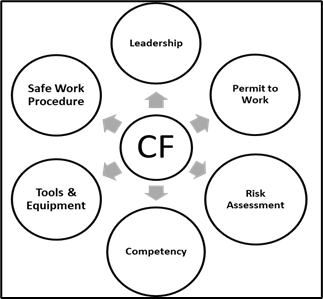Bowtie Analysis for Risk Assessment of Confined Space at Sewerage Construction Project
DOI:
https://doi.org/10.37934/progee.24.1.2234Keywords:
Confined space, Risk assessment, Accident, OSHA 1994, FMA 1967, ICOP 2010, ISO31000, ISO31010Abstract
This paper aims to investigate the issues related to safety in confined space at the sewerage treatment plant construction project in the Hulu Langat district and to provide a solution by proposing a substantial approach to mitigating risk during confined space entry due to an ineffective risk assessment and poor compliance by project management. The methods used were site visit observation and survey, followed by an analysis of the selected risk assessment method. The site visit to the sewerage treatment plant project investigated the compliance of confined space risk assessment documents to established requirements such as OSHA 1994, FMA 1967, ICOP 2010, HIRARC Guidelines 2008, Quebec Regulation 2015, ISO 31010, HSE UK, and BCGA UK. The selected risk assessment method was analyzed with Bowtie Risk Assessment by referring to the preventive approach concept or barrier analysis. Next, additional information relevant to risk assessment from journals was included. Evaluation of Bowtie Risk Assessment was conducted through a focus group discussion (FGD), which plays an essential role in developing the Bowtie risk assessment graphical framework. The proposed Bowtie Risk Assessment graphical framework provides a sewerage treatment plant construction project with a holistic technique for preventing confined space accidents. It also provides a safe work system, manages hazards and risks effectively, promotes good leadership practices, improves company reputation, and significantly reduces accident costs. The framework is also helpful as a reference model for other industry players.
References
T.A. Kletz, Mining the past, Journal of Hazardous Materials 142 (2007) 618–625. https://doi.org/10.1016/j.jhazmat.2006.06.067.
Department of Occupational Safety and Health, Guidelines for Hazard Identification, Risk Assessment and Risk Control, Ministry of Human Resource Malaysia, 2008.
Standards Australia, AS/NZS 2865:2001, Ds Sydney: Standards Australia, 2001.
International Organization for Standardization, Risk Management – Risk Assessment Techniques, IEC/ISO31010:2009, Geneva, Switzerland, 2009.
D. Burlet-Vienney, Y. Chinniah, A. Bahloul, B. Roberge, Design and application of a 5 step risk assessment tool for confined space entries, Safety Science 80 (2015) 144–155. https://doi.org/10.1016/j.ssci.2015.07.022.
A.C. Caputo, P.M. Pelagagge, P. Salini, AHP-based methodology for selecting safety devices of industrial machinery, Safety Science 53 (2013) 202–218. https://doi.org/10.1016/j.ssci.2012.10.006.
A. Stojkovic, Occupational safety in hazardous confined space, Safety Engineering 3 (2013) 137–144. https://doi.org/10.7562/SE2013.3.03.05.
D. Burlet-Vienney, Y. Chinniah, A. Bahloul, The need for a comprehensive approach to managing confined space entry: Summary of the literature and recommendations for next steps, Journal of Occupational and Environmental Hygiene 11 (2014) 485–498. https://doi.org/10.1080/15459624.2013.877589.
E.A. Kapp, The influence of supervisor leadership practices and perceived group safety climate on employee safety performance, Safety Science 50 (2012) 1119–1124. https://doi.org/10.1016/j.ssci.2011.11.011.
S.P. Pereira, Gas Testing for Confined Space Entry, in: ASSE Professional Development Conference and Exposition, ASSE-12-693, 2012. https://onepetro.org/ASSPPDCE/proceedings-abstract/ASSE12/All-ASSE12/ASSE-12-693/76040.
J.G. Pouzou, C. Warner, R.L. Neitzel, G.A. Croteau, M.G. Yost, N.S. Seixas, Confined space ventilation by shipyard welders: Observed USE AND EFFECTIVENESS, The Annals of Occupational Hygiene 59(1) (2014) 116–121. https://doi.org/10.1093/annhyg/meu070.
T.D. Smith, R. Herron, A. Le, J.K. Wilson, J. Marion, D.A. Vicenzi, Assessment of confined space entry and rescue training for aircraft rescue and fire fighting (ARFF) members in the United States, Journal of Safety Research 67 (2018) 77–82. https://doi.org/10.1016/j.jsr.2018.09.014.
J. Selman, J. Spickett, J. Jansz, B. Mullins, Confined space rescue: A proposed procedure to reduce the risks, Safety Science 113 (2019) 78–90. https://doi.org/10.1016/j.ssci.2018.11.017.
Department of Occupational Safety and Health, Industry Code of Practice For Safe Working in a Confined Space, Ministry of Human Resource Malaysia, 2010.
Occupational Safety and Health Act. (Act 514), Malaysia,1994.
Factories and Machinery Act. (Act 139), Malaysia, 1967.
D. Burlet-Vienney, Y. Chinniah, A. Bahloul, B. Roberge, Risk analysis for confined space entries: Critical analysis of four tools applied to three risk scenarios, Journal of Occupational and Environmental Hygiene 13 (2016) D99–D108. https://doi.org/10.1080/15459624.2016.1143949.
A. Moatari-Kazerouni, Y. Chinniah, B. Agard, A proposed occupational health and safety risk estimation tool for manufacturing systems, International Journal of Production Research 53(15) (2014) 4459–4475. https://doi.org/10.1080/00207543.2014.942005.
K. Reinhold, M. Jarvis, P. Tint, Practical tool and procedure for workplace risk assessment: Evidence from SMEs in Estonia, Safety Science 71(C) (2015) 282–291. https://doi.org/10.1016/j.ssci.2014.09.016.
O.N. Aneziris, I.A. Papazoglou, M. Mud, M. Damen, L.J. Bellamy, H.J. Manuel, J. Oh, Occupational risk quantification owing to falling objects, Safety Science 68 (2014) 57–70. https://doi.org/10.1016/j.ssci.2014.02.017.
I. Voicu, F. v Panaitescu, M. Panaitescu, L.G. Dumitrescu, M. Turof, Risk management with Bowtie diagrams, IOP Conference Series: Materials Science and Engineering 400 (2018) 082021. https://doi.org/10.1088/1757-899X/400/8/082021.
J. Aust., D. Pons, Bowtie methodology for risk analysis of visual borescope inspection during aircraft engine maintenance, Aerospace 6(10) (2019) 110. https://doi.org/10.3390/aerospace6100110.
H. Dong, Y. Liu, D. Zhao, M. Qi, J. Chen, Lessons learned from analyzing an explosion at Shanghai SECCO petrochemical plant, Process Safety Progress 39(1) (2019) e12094. https://doi.org/10.1002/prs.12094.
A.C. Duke, Emergency response for toxic gas release incidents, in: All Days, SPE, 2012. https://doi.org/10.2118/152611-MS.
International Organization for Standardization, Risk Management – Principles and Guideline, IEC/ISO 31000:2009, Geneva, Switzerland, 2009.
S.P. Pereira, Gas Testing for Confined Space Entry, in: ASSE Professional Development Conference and Exposition, ASSE-12-693, 2012. https://onepetro.org/ASSPPDCE/proceedings-abstract/ASSE12/All-ASSE12/ASSE-12-693/76040.
O.N. Aneziris, I.A. Papazoglou, M. Konstandinidou, H. Baksteen, M. Mud, M. Damen, L.J. Bellamy, J. Oh, Quantification of occupational risk owing to contact with moving parts of machines, Safety Science 51(1) (2013) 382–396. https://doi.org/10.1016/j.ssci.2012.08.009.
P.K. Marhavilas, D.E. Koulouriotis, C. Mitrakas, On the development of a new hybrid risk assessment process using occupational accident's data: Application on the Greek Public electric Power Provider, Journal of Loss Prevention in the Process Industries 24 (2011) 671-687. https://doi.org/10.1016/j.jlp.2011.05.010.
O. Rozenfeld, R. Sacks, Y. Rosenfeld, H. Baum, Construction Job Safety Analysis, Safety Science 48(4) (2010) 491-498. https://doi.org/10.1016/j.ssci.2009.12.017.
Ivan W.H. Fung, Vivian W.Y. Tam, Tommy Y. Lo and Lori L.H. Lu, Developing a risk assessment model for construction safety, International Journal of Project Management 28(6) (2010) 593–600. https://doi.org/10.1016/j.ijproman.2009.09.006.

Downloads
Published
How to Cite
Issue
Section
License
Copyright (c) 2023 Progress in Energy and Environment

This work is licensed under a Creative Commons Attribution-NonCommercial 4.0 International License.











